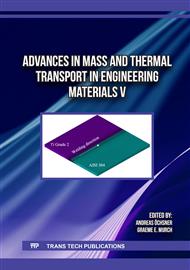p.139
p.147
p.157
p.165
p.179
p.189
p.209
p.221
p.233
Ti-5Mo-xNb Alloys Obtained by Laser Deposition with Potential Use as Biomaterials
Abstract:
Titanium and its alloys could have good biocompatibility, suitable levels of strength, fracture toughness, fatigue resistance and low elastic modulus, which are requirements for metallic materials used as biomaterials. Implants of commercially available Ti alloys show excessive levels of stiffness that cause stress shielding and often lead to bone resorption and failure. For better biomechanical performance, it is necessary to redesign biomaterials with lower elastic modulus. Alloying Ti with β-stabilizing elements (Ta, Mo, Nb) allows obtaining alloys with Young´s modulus closer to that of bone (10-30 GPa), minimizing the tendency for stress shielding and bone resorption. A combinatorial method, based on variable composition laser deposition, has been used for synthesizing alloys with a gradient of composition along a single clad track and scanning for the most interesting compositions. This study reports results on laser synthesis of alloys in the Ti-5Mo-xNb system, in search for compositions with microstructure and properties optimized for use as biomaterials. The alloys were then characterized in composition and microstructure by X-ray diffraction, scanning electron microscopy and energy dispersive X-ray spectroscopy. The mechanical properties were assessed using depth-sensing ultramicroindentation tests. Their microstructures consist of the orthorhombic α’ phase with martensitic morphology, and untransformed β. The alloys indentation hardness increased with the Nb content from 2.79 ± 0.02 GPa to 3.7 ± 0.8 GPa, due to solid solution strengthening. The same trend was observed in the elastic moduli that increased from 38.8 ± 8.1 GPa to 76 ± 13 GPa, and in addition the H/E ratio was greater than 0.04 for all samples which indicates good wear resistance. Despite being dual phase (α’+β) all compositions present elastic modulus that are considerably lower than those of commercial Ti alloys currently used (above 100 GPa).
Info:
Periodical:
Pages:
179-187
Citation:
Online since:
February 2025
Keywords:
Price:
Сopyright:
© 2025 Trans Tech Publications Ltd. All Rights Reserved
Share:
Citation:


